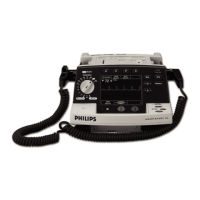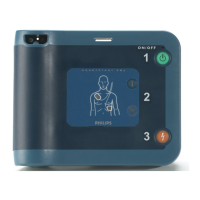B: Theory of Operation Functional Descriptions
200
Patient Impedance Functions
The HeartStart XL+ measures patient impedance in two ways: an impedance measurement before the
shock, and a impedance measurement during the shock.
Before the Shock
The HeartStart XL+ makes a small-signal AC impedance measurement (at 32 kHz) in the steady state
situation before a shock is delivered. This measurement is used to detect Pads Off and Paddles Off. It is
also used for the Patient Contact Indicator (PCI) function, in which the quality of the contact the
paddles are making with the patient is indicated on an LED bar graph on the Sternum paddle.
During the Shock
The HeartStart XL+ also makes an impedance measurement during shock delivery. This impedance is
derived from measurements of voltage and current, and is reported on the printed event summary. The
device uses the value of the impedance to adjust the phase durations of the biphasic waveform and to
provide the optimal waveform delivery. This information is also used to abort the shock if necessary.
Since the before-the-shock measurement is a small-signal AC measurement of impedance, and the
during-the-shock one is a high-voltage/high-current measurement of impedance, it is normal and
expected for the two measurements to produce slightly different numerical results. The high-current
measurement is used in shock delivery, therefore it may seem inconsistent with the PCI indication.
Defibrillation
The following sections describe the defibrillation functions.
Charge
There are three basic events that can initiate a charging cycle:
• In AED Mode, when the Processor PCA shock advisory analysis algorithm determines from the pads
ECG waveform that a shock is needed.
• In Manual Defibrillation Mode with either pads or paddles, when the front panel Charge button is
pressed, the button press is then detected and processed by the Processor PCA.
• In Manual Defibrillation Mode with external paddles only, when the Apex paddle Charge button is
pressed, the button press is transferred from the button to the Processor PCA. The button press is
then detected and processed by the Processor PCA.
In all cases, the charging cycle is initiated by the Processor PCA. It directs the Therapy PCA to charge the
Therapy capacitor to a specified level. A controller on the Therapy PCA is responsible for all aspects of
charging the Therapy capacitor to the specified level. However, the Processor PCA monitors the voltage
on the capacitor and aborts the shock if the capacitor voltage is not consistent with the specified level.
When the Therapy PCA detects that the selected energy (voltage) level has been reached, it stops
charging. It then continues to monitor the voltage on the capacitor, and as the voltage bleeds down, it
resumes charging to top up the charge to the correct level.
Should a decision be made to change the selected energy to a lower value, the user would turn the
Therapy Knob to the desired setting. At the lower energy setting, the Processor PCA directs the Therapy
PCA to charge to the new level. The Therapy PCA then disarms (completely discharges) the capacitor
and charges up to the new (lower) level. At a higher energy setting, the Therapy PCA charges the
capacitor until the new level is reached.
If the requested charge is not used within the configured “time to auto disarm” (30, 60, or 90 seconds),
the Processor PCA automatically directs the Therapy PCA to disarm the capacitor as a safety precaution.

